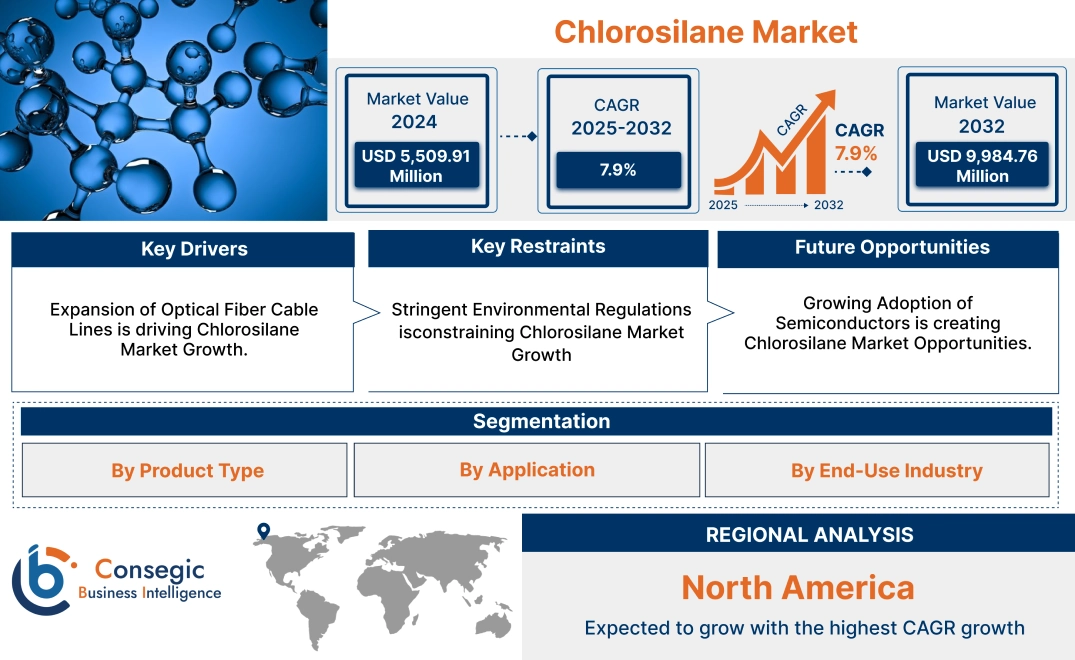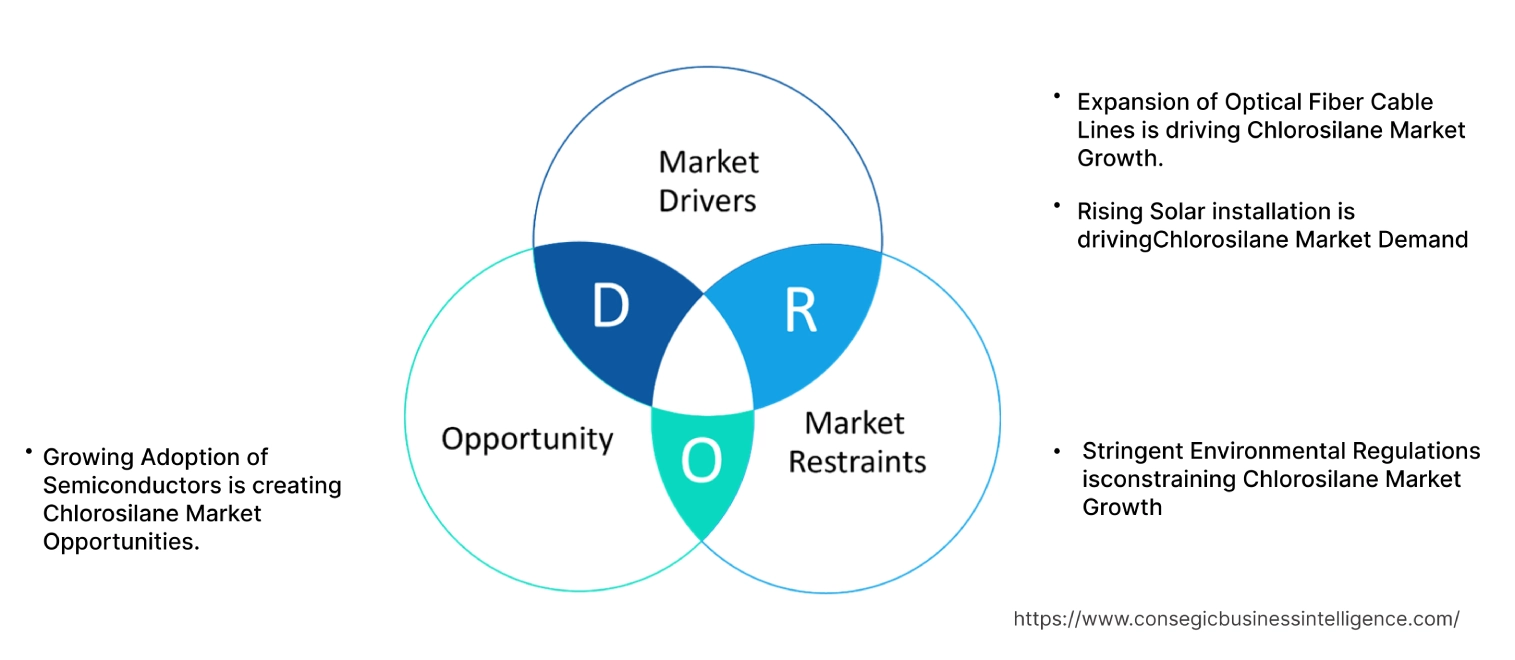Chlorosilane Market Size:
Chlorosilane market size is estimated to reach over USD 9,984.76 Million by 2032 from a value of USD 5,509.91 Million in 2024, growing at a CAGR of 7.9% from 2025 to 2032.
Chlorosilane Market Scope & Overview:
Chlorosilane refers to a group of chemical compounds composed of silicon, hydrogen, and chloride. These compounds are primarily used as intermediaries in the production of polysilicon, which is essential for manufacturing solar cells, semiconductors, and other electronic components. Chlorosilane possesses characteristics such as high reactivity, purity, thermal stability, and other properties. It is also crucial in the synthesis of silicone, widely used in industries such as construction, automotive, personal care, and others. Key types include silicone tetrachloride, dimethylchlorosilane, and methylchlorosilane amongst others, each serving industrial applications. These compounds are highly reactive and play a vital role in processes like chemical vapor deposition to create high-purity silicon. Chlorosilane is widely used in applications such as polymers, optical fibers, adhesives, lubricants, and others, further driving the market.
How is AI Impacting the Chlorosilane Market?
AI is significantly impacting the chlorosilane market by boosting efficiency, accelerating research, and enhancing sustainability. AI-powered tools optimize chemical synthesis, predict material properties, and streamline production processes, leading to faster innovation and cost reductions. Also, AI contributes to more sustainable manufacturing practices through optimized resource utilization and waste reduction. Additionally, AI algorithms analyze vast datasets of chemical information and predict potential chlorosilane structures and their properties, significantly reducing the time and cost associated with traditional R&D. Moreover, AI optimize energy usage in chlorosilane production processes, leading to lower energy consumption and reduced environmental impact.
Chlorosilane Market Dynamics - (DRO) :
Key Drivers:
Expansion of Optical Fiber Cable Lines is driving Chlorosilane Market Growth..
Optical fiber cable lines offer superior bandwidth, durability, and efficiency compared to traditional cable lines used in digital infrastructure. Chlorosilane particularly, silicon tetrachloride is used in the manufacturing of optic fiber cable. It is critical for the chemical vapor deposition process to produce ultrapure silicon, which forms the core and cladding of optical fiber cable lines.
- In 2023, according to the China Internet Network Information Center report, by June 2023, the total length of optic fiber cable lines increased by 2.38 million kilometers compared with December 2022 in China. Optic fiber cable lines are manufactured using silicone tetrachloride, a type of chlorosilane for high-speed data transmission in telecommunications, 5G networks, and internet services.
Thus, the growing use of optic fiber is leading to chlorosilane market demand, due to the rising need for silicone tetrachloride in the production of silicon in optical fiber.
Rising Solar installation is drivingChlorosilane Market Demand
Solar installations like solar cells, solar panels, and other solar systems are growing significantly due to the preference for clean and renewable energy. Chlorosilane such as silicon tetrachloride and trichlorosilane are essential in solar installations for providing good quality silicon, which is crucial for generating effective solar energy. They produce high-purity silicon in solar installations through a chemical vapor deposition process.
- In 2023, according to Solar Power Europe, global solar yearly installations grew to 87% from the solar installation since the year 2002. Chlorosilane, particularly silicon tetrachloride and trichlorosilane are essential for solar installations providing high-purity silicon. The preference for solar installations is rising due to government support, eco-friendly practices, and a shift towards sustainability, further enhancing the chlorosilane market.
Thus, growing solar installations are driving chlorosilane market expansion, for providing high-purity silicon in solar cells.
Key Restraints:
Stringent Environmental Regulations is constraining Chlorosilane Market Growth
The production of chlorosilane involves the use of hazardous chemicals such as chlorine, which generates toxic byproducts like hydrochloride acid and other volatile compounds. To mitigate the environmental impact, governments worldwide have introduced stringent regulations on the manufacturing process of chlorosilane. These regulations include tighter emission controls, waste disposal guidelines, and the implementation of sustainable production practices. Compliance with each governmental regulation typically requires companies to invest in advanced filtration systems, waste treatment technologies, and specialized safety measures which leads to higher operational costs for chlorosilane manufacturers.
Thus, stringent environmental regulations are constraining the market by increasing operational costs and delays in product launches.
Future Opportunities :
Growing Adoption of Semiconductors is creating Chlorosilane Market Opportunities.
Adoption of semiconductors is rising due to 3D chip design, advanced electronics, and other factors. Chlorosilane, particularly silicon tetrachloride and trichlorosilane are important semiconductors for providing high-purity silicon. They played a vital role in the semiconductors for good energy flow and heat resistance, further enhancing the semiconductor's properties.
- In 2024, according to the Semiconductor Energy Association, global semiconductor sales increase by 23.2% as compared to the year 2023. Chlorosilane, particularly silicon tetrachloride and trichlorosilane is used in the semiconductors for the chemical deposition process, producing good energy flow and developing heat resistance. The use of semiconductors is fueled by to proliferation of laptops, smartphones, and other semiconductor devices.
Hence, the growing adoption of semiconductors is creating chlorosilane market opportunities for providing polysilicon through the chemical deposition process.
Chlorosilane Market Segmental Analysis :
By Product Type:
By product type, the market is divided into silicon tetrachloride, trichlorosilane, ethylchlorosilane, methylchlorosilane, and others.
Trends in Product Type
- As per chlorosilane market trends, silicon tetrachloride is widely used in solar panels and semiconductors for heat resistance, flexibility, and durability.
- Use of methylchlorosilane is rising in industries such as automotive, healthcare, electronics, and others as per market trends.
The silicon tetrachloride accounted for the largest market share in the year 2024.
- Silicon tetrachloride is a key chlorosilane type used in the production of polysilicon and silicone products.
- It is produced by reacting silicon with chloride gas, forming silicon chloride, as a byproduct.
- In solar, silicon tetrachloride is an essential intermediate in the production of high-purity silicone, which is a vital material for manufacturing solar panels.
- Silicon tetrachloride is also used in the production of silicon wafers for semiconductors and other electronic devices.
- Additionally, it is involved in the chemical deposition process to deposit silicon coatings on substrates.
- Thus, silicon tetrachloride is widely used chlorosilane which is used for the production of high-purity silicon.
The methylchlorosilane is expected to grow at the fastest CAGR over the forecast period.
- Methylchlorosilane is largely being incorporated in the manufacture of silicone rubber, silicone fluids, and silicone resins, contributing to industries such as automotive, healthcare, electronics, and others.
- It is primarily used as a raw material for the synthesis of trimethylchlorosilane, methyphenylchlorosilane, and other methyl silicon compounds, which are essential in industries like automotive, construction, paints & coatings, and others. Further, methyphenylchlorosilane is widely used in applications such as adhesives, lubricants, semiconductors, and others.
- Companies are largely investing in the production of methyphenylchlorosilane to cater to growing use in these applications.
- For instance, in 2024, Shandong Baolongda Industrial Group Co. Ltd. invested in in production project of methyphenylchlorosilane. It is expected that the annual production capacity will increase to 20,000 tons annual product capacity of methyphenylchlorosilane. It will lead to an increase in the production of methylchlorosilane, thereby enhancing the market.
- Thus, methylchlorosilane is rapidly using chlorosilane due to its various applications in industries like automotive, construction, paints & coatings, and others.
By Application:
By application, the market is divided into semiconductors, adhesives, optical fiber, polymers, and others.
Trends in Application
- As per chlorosilane market trends, silicon tetrachloride and trichlorosilane are widely used in semiconductors for high-purity polysilicon production.
- Chlorosilane is largely incorporated in optical fibers for high-speed data transmission in telecommunications and internet services.
Semiconductors accounted for the largest market share in the year 2024.
- Chlorosilane, particularly silicon tetrachloride, and trichlorosilane, plays a crucial role in semiconductors.
- These chlorosilanes are primarily used to produce high-purity polysilicon, which is essential for manufacturing semiconductor wafers.
- Use of semiconductors is rising due to 3D chip design, advanced electronics, and other factors, which lend to the production of semiconductors.
- For instance, in 2024, Suchi Semicon launches a semiconductor production plant in India investing USD 100 million over the next three years. Chlorosilane, particularly silicon tetrachloride and trichlorosilane are critical for the production of semiconductors, further enhancing the market.
- Thus, chlorosilane is widely used in semiconductors due to its high-purity polysilicon production
The optical fiber is expected to grow at the fastest CAGR over the forecast period.
- Chlorosilanes are being largely used in the production of optical fibers, which are essential for high-speed data transmission in telecommunications and internet services.
- Chlorosilane, particularly silicon tetrachloride is used in the chemical vapor deposition process to create high-purity silicon fibers, the core material of optical fiber.
- These silica fibers offer superior light transmission properties with minimal signal loss, making them ideal for high-bandwidth communication systems.
- As the global 5G network is rising, smart cities and digital connectivity grow, the need for optical fiber expands, driving the use of chlorosilanes.
- Thus, chlorosilane is widely used in optical fibers for high-speed data transmission and minimal signal loss in telecommunications and internet services.
By End-Use Industry:
By end-use industry, the market is divided into electronics & semiconductors, renewable energy, paints & coatings, construction, and others.
Trends in End-Use Industry:
- As per market trends, chlorosilane is widely used in electronics & semiconductors for manufacturing circuits, transistors, and other devices.
- Chlorosilane is largely being used in renewable energy in solar panel manufacturing for providing high-purity polysilicon as per market trends.
The electronics & semiconductors accounted for the largest market share of 41.77% in the year 2024.
- In electronics and semiconductors, chlorosilane plays a pivotal role in the production of high-purity polysilicon.
- Silicon tetrachloride, a key chlorosilane is extensively used in the production of polysilicon, which is a crucial material for manufacturing circuits, transistors, and other semiconductor devices.
- As the use of consumer electronics, smartphones, computers, and other devices continues to rise, the need for high-quality polysilicon increases, further driving the growth of the chlorosilane market in this sector.
- Additionally, chlorosilane is involved in the production of silicon-based photonic devices and solar cells, which are integral to electronic applications such as laptops, smartwatches, tablets, and others.
- Thus, chlorosilane is widely used in the electronics & semiconductor industry, due to the rising need for high-purity polysilicon in laptops, mobiles, and other products.
Renewable energy is expected to grow at the fastest CAGR over the forecast period.
- The incorporation of chlorosilane is rising in renewable energy, particularly through its applications in polysilicon production for solar energy.
- Polysilicon is a critical material used in the manufacturing of solar panels, which are key components of rooftop solar energy systems.
- Due to the rising shift towards sustainability and eco-friendly practices, companies are promoting the adoption of rooftop solar energy systems, further driving the chlorosilane market.
- For instance, in 2024, Tata Power Renewable Energy Limited partnered with Canara Bank to promote the adoption of rooftop solar systems under the PM Surya Ghar Scheme. Rooftop solar systems incorporate chlorosilane for the production of polysilicon which are essential for effective solar cells in the solar systems.
- Thus, the use of chlorosilane is growing significantly in the renewable energy sector due to the need for effective solar energy systems.
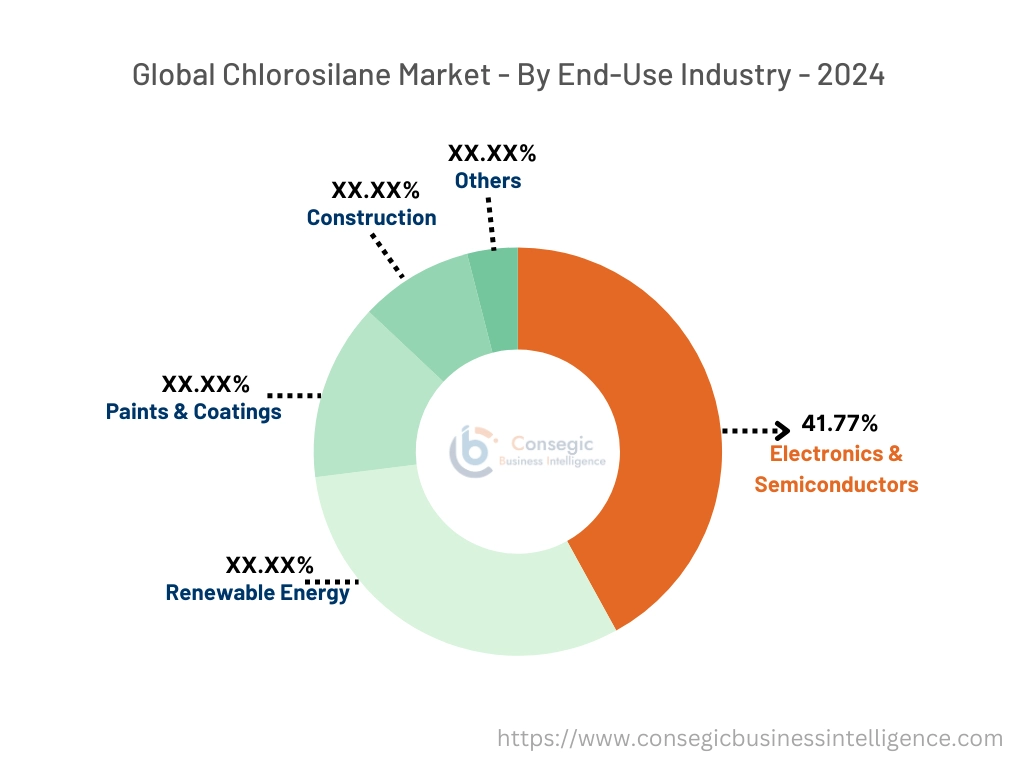
Regional Analysis:
The regional segment includes North America, Europe, Asia Pacific, the Middle East and Africa, and Latin America.
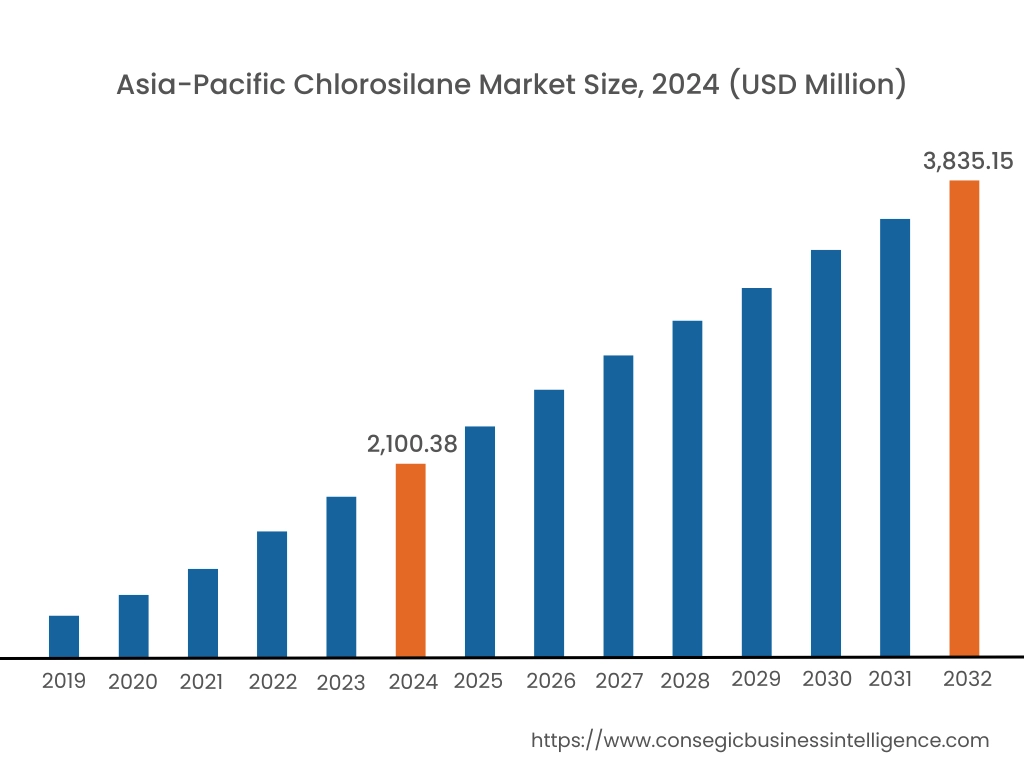
The regional segment includes North America, Europe, Asia Pacific, the Middle East and Africa, and Latin America.
In 2024, Asia Pacific accounted for the highest market share at 38.12% and was valued at USD 2,100.38 Million and is expected to reach USD 3,835.15 Million in 2032. In Asia Pacific, China accounted for the highest market share of 26.74% during the base year of 2024. The chlorosilane market share of the Asia-Pacific region is rising due to the region’s strong focus on renewable energy and electronics manufacturing. Countries like China, India, Japan, and South Korea are heavily investing in photovoltaic (PV) cell manufacturing to expand solar energy adoption in the region. Chlorosilane, particularly silicone tetrachloride is used in the production of PV cells for providing high-purity polysilicon, critical for good energy flow and thermal stability.
- According to the ORF America report, India’s installed solar PV cell capacity was 75.6 gigawatt (GW) in February 2024 and India is targeting 300 GW of solar PV capacity by 2030, necessitating a significant buildout of solar projects. Chlorosilane, particularly, silicon tetrachloride is used in the production of PV cells for providing high-quality polysilicon through a chemical diffusion process. This high-quality polysilicon is essential for the functioning of PV cells providing thermal stability and good conductivity.
Thus, Asia-Pacific is dominating the market due to the well-established electronics sector and expanding renewable energy adoption.
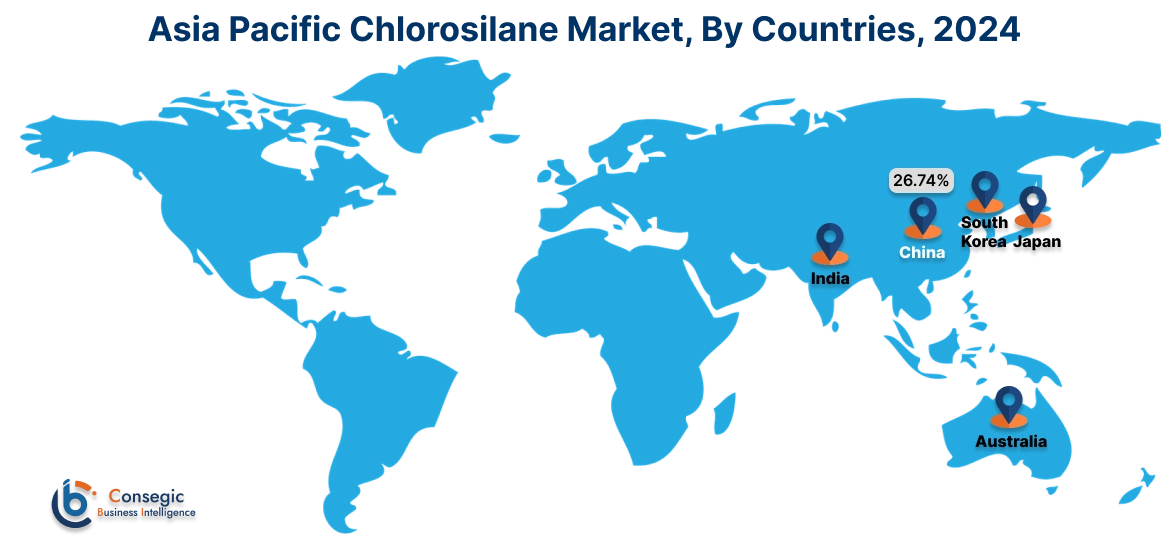
North America is expected to witness the fastest CAGR of 8.4% over the forecast period of 2025-2032. As per the chlorosilane market analysis, North America is witnessing steady growth, driven by advancements in semiconductors, renewable energy, and construction. The region’s strong emphasis on solar energy adoption, particularly in the United States, has significantly increased the demand for high-purity polysilicon, a critical material for solar panel production derived from chlorosilane. The region’s robust electronics sector also fuels the market, as chlorosilane is vital for manufacturing semiconductors used in various devices and technologies. Additionally, the construction sector in the region benefits from the use of silicone-based sealants, coatings, and adhesives, which enhance durability and environmental resistance. Thus, the chlorosilane market share in North America is growing significantly, due to expanding construction and the solar sector as per the analysis.
According to chlorosilane market analysis, the Europe region is experiencing significant growth in the market, driven by advancements in key industries such as renewable energy, electronics, and construction. Europe is a prominent player in the global solar energy sector, with increasing investments in solar panel installations to meet renewable energy targets and carbon neutrality goals. This has significantly boosted the demand for high-purity polysilicon, a critical material for solar panels produced using chlorosilane. Additionally, the region’s well-established automotive and construction sectors are driving the use of chlorosilanes in silicone-based adhesives, lubricants, and coatings, which offer durability and environmental resistance. Additionally, the presence of leading chemical manufacturers are increasingly using chlorosilane in various chemicals, further accelerating the market as per the analysis.
The chlorosilane market expansion in the Middle East and Africa is growing moderately, due to growing investments in renewable energy projects and industrial developments. The region’s focus on solar energy adoption, particularly in countries like Saudi Arabia, UAE, and South Africa, is a significant driver. These nations are investing heavily in solar power infrastructure to diversify their energy production and reduce reliance on fossil fuels, boosting the demand for polysilicon produced using chlorosilane. In addition, the region is growing in terms of the construction sector which utilizes chlorosilane for paints, coatings, adhesives, and lubricants, offering enhanced durability and water resistance in challenging climates as per market analysis.
As per market analysis, the market is growing in Latin America is growing steadily, supported by the region’s focus on renewable energy development and industrial growth. Countries like Brazil, Chile, and Mexico are investing heavily in solar energy projects to meet rising energy demands and reduce carbon emissions, which are produced using chlorosilane. Additionally, the region’s expanding construction sector is driving the use of chlorosilane-based products such as adhesives, paints, coatings, and lubricants, enhancing durability and weather resistance. The automotive sector in Brazil is also contributing to demand, particularly for silicone components that improve efficiency and performance, further driving the market growth in the region.
Top Key Players and Market Share Insights:
The chlorosilane industry is highly competitive with major players providing products to the national and international markets. Key players are adopting several strategies in research and development (R&D) and product innovation to hold a strong position in the global chlorosilane market. Key players in the chlorosilane industry include-
- Evonik (Germany)
- Shin-Etsu Chemical Co., Ltd (Japan)
- Wacker Chemie AG (Germany)
- Linde AG (Ireland)
- Wynca Group (China)
- Gelest Inc. (United States)
- Tokuyama Corporation (Japan)
- Merck KGaA (Germany)
- OCI Company Ltd (South Korea)
- Dow Inc. (United States)
Recent Industry Developments :
Business Expansion:
- In 2021, Elkem announced nearly USD 42 million at its plant in Roussillon, France, in a project designed to benefit its customers in the Americas, as well as in Europe, the Middle East, and Africa region. It enhances the production of silicon metal into chlorosilanes, vinyl chlorosilanes, and siloxanes at the Roussillon plant.
Chlorosilane Market Report Insights :
| Report Attributes | Report Details |
| Study Timeline | 2019-2032 |
| Market Size in 2032 | USDUSD 9,984.76 Million |
| CAGR (2025-2032) | 7.9% |
| By Product Type |
|
| By Application |
|
| By End Use Industry |
|
| By Region |
|
| Key Players |
|
| North America | U.S. Canada Mexico |
| Europe | U.K. Germany France Spain Italy Russia Benelux Rest of Europe |
| APAC | China South Korea Japan India Australia ASEAN Rest of Asia-Pacific |
| Middle East and Africa | GCC Turkey South Africa Rest of MEA |
| LATAM | Brazil Argentina Chile Rest of LATAM |
| Report Coverage |
|
Key Questions Answered in the Report
How big is the chlorosilane market? +
In 2024, the chlorosilane market is USD 5,509.91 Million.
Which is the fastest-growing region in the chlorosilane market? +
North America is the fastest-growing region in the chlorosilane market.
What specific segmentation details are covered in the chlorosilane market? +
Product type, application, and end-use industry are covered in the chlorosilane market.
Who are the major players in the chlorosilane market? +
Evonik (Germany), Shin-Etsu Chemical Co., Ltd (Japan), and Gelest Inc. (United States) are some of the major players in the market.
